#Dan Taulapapa McMullin
Text
Happy Asian Pacific American Heritage Month 2024!
Happy Asian Pacific American Heritage Month 2024! And if you’re Canadian, Happy Asian Heritage Month! Come celebrate with all the books! (And get even more recs from past years’ posts!)
(Note: not all of the Asian authors or characters in these titles are specifically American. I thought it was worth highlighting more books than that specific title allowed.)
Picture Books
I Am a Rainbow! by Mark…
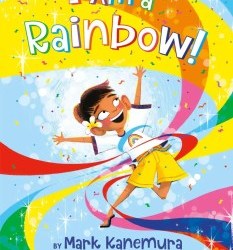
View On WordPress
#A Banh Mi for Two#AAPI#API#Asian American#Chinese#Dan Taulapapa McMullin#Desi#Erin Baldwin#featured#Filipino#Gay the Pray Away#Hawaiian#Indian#Indonesia#Iranian#Japanese#Korean#Lulu Sinagtala and the City of Noble Warriors#Maori#Medusa of the Roses#Natalie Naudus#Navid Sinaki#Pacific Islander#Persian#Robin Ha#Samoan#Samoan Queer Lives#Sascha Stronach#The Dark We Know#The Fox Maidens
27 notes
·
View notes
Text


Images from The Healer's Wound: A Queer Theirstory of Polynesia (2022) by Dan Taulapapa McMullin, Samoan artist and author.
#queer artist#literature#lgbtq#Fa’afafine#photography#nonbinary#samoan#Dan Taulapapa McMullin#indigenous
85 notes
·
View notes
Text
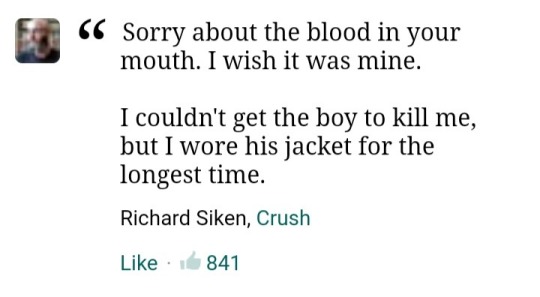








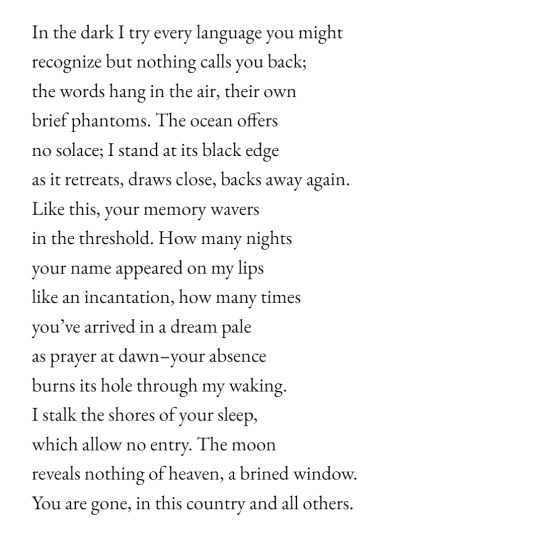
I love you. I'm sorry it didn't work out.
Richard Siken, Crush | Dan Taulapapa McMullin, The Sky | Dionisio d. Martinez, A Dove is not a Bird | Makoto Shinkai, Garden of Words | @haleyincarnate | Ross Gay, Catalog of Unabashed Gratitude | Caitlyn Siehl, This is Not a Love Poem | @-love-letters-i-never-sent | Leila Chatti, Night Lament in Hergla |
#web weaving#break up#dark academia#moving on#poems on tumblr#poems and quotes#litblr#books#loss#garden of words#love#grief#memory#moodboard
471 notes
·
View notes
Text



the best thing i ever did was let you go
dan taulapapa mcmullin the sky \\ fatima ronquillo refusal: hand with maya angelou \\ c.d. wright steal away: new and selected poems: “everything good between men and women”
kofi
#on breaking up#on love#on self#on identity#mine#my webweaving#webweaving#web weaving#webweave#web weave#webs#ww#parallel#parallels#parallelism#intertextuality#compilation#compilations#dan taulapapa mcmullin#the sky#fatima ronquillo#refusal#refusal: hand with maya angelou#cd wright#c.d. wright
225 notes
·
View notes
Photo

Dan Taulapapa McMullin
Gender: Fa'afafine - Third gender (he/him)
Sexuality: Queer
DOB: 23 May 1957
Ethnicity: Indigenous Samoan, Jewish, Irish
Occupation: Artist, poet, writer, sculptor
#Dan Taulapapa McMullin#qpoc#third gender#Fa'afafine#queer#1957#native#samoan#jewish#poc#biracial#irish#artist#poet#writer#sculptor#popular post#200
297 notes
·
View notes
Text

- from The Sky // Dan Taulapapa McMullin
#poetry#poem#quote#writing#verse#free verse#dan taulapapa mcmullin#family#parents#loss#freedom#love#poc poet#samoan poet#samoan fa'afafine poet#01172022#id in the alt text
3 notes
·
View notes
Photo

Dan Taulapapa McMullin is a poet, artist, sculptress, and film maker currently located in Hudson, New York and California. They self-identify as Fa’afafine, which is a third gender/non-binary identity within Samoa, American Samoa, and the Samoa diaspora.
Dan’s work focuses on celebrating and shining light on their Samoan heritage and Fa’afafine identity, with a career of 35 years in producing art. Their short film “Sinaela” (2002) received the Best Short Film at the Honolulu Rainbow Film Festival.
In fact, Dan had worked on a very interesting and exciting project just a year ago on excavating queer Polynesian history and heritage titled “A Queer Theirstory of Polynesia”. The project was exhibited at Hudson Eye as an installation, and recently published as a book! Please check out Dan’s website and queersoutheastasia.com for more info!
Queer identities within the Pacific islands and south/southeast/southwest Asia are so diverse and important, nonetheless hardly mentioned and easily erased. I acknowledge my privilege as being an East Asian immigrant, and endeavour to learn more about the culture and heritage of queer communities and people from these regions.
*sources: http://queersoutheastasia.com/a-queer-theirstory-of-polynesia, https://www.ruralintelligence.com/community/the-rural-we-dan-taulapapa-mcmullin, and https://www.taulapapa.com/
2 notes
·
View notes
Text
Back to my body, my queer Samoan body, my aging but still beautiful, to someone somewhere, queer Samoan naked or clothed in colonialism body. Speechless as it is. Without the words...
As in the old Samoan poem of Tagaloa, the creator of all islands: a wind from the sea is strong, but a breeze falling from the green ridge is soft, from Samoa inland, where Tagaloa sleeps.
Dan Taulapapa McMullin, from ‘Over My Queer Samoan Body’
100 notes
·
View notes
Photo


Pasifika in Print; Queer Indigenous Studies : Critical Interventions in Theory, Politics and Literature. On Tagaloa, Jesus, and Nafanua. Dan Taulapapa McMullin
found here
#Qwo-Li Driskill#Dan Taulapapa McMullin#Fa'afafine#Samoa#LBGTQI#Pasifika#Pasifika in Print#srry the excerpts are messy but there was so many good parts
22 notes
·
View notes
Text

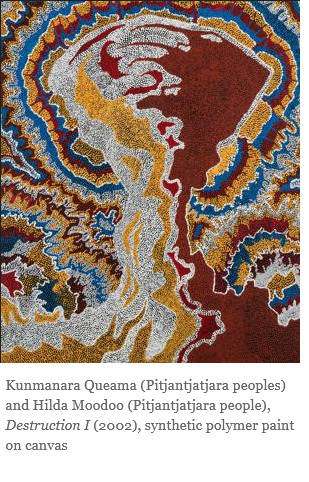
At 6.9 feet in height and 6.2 feet in diameter, Ainu artist Kohei Fujito’s iron sculpture, The Singing of the Needle (2021), is an imposing size, with an iron screen bristling with rough spirals barbed with spikes. A painted deer skull is mounted on a pole at its center, surrounded on all sides by the iron screen like it’s being shielded, from some external threat. In 2011, in the wake of the Fukushima Daiichi nuclear disaster in Japan, Fujito was concerned about the effect of radioactive winds on his Ainu family and community on Hokkaido, Japan’s northernmost prefecture.
“The spiral pattern throughout the work is based on a traditional Ainu symbol for wind,” says Manuela Well-Off-Man, chief curator at the Institute of American Indian Arts’ Museum of Contemporary Native Arts. [...]
Exposure: Native Art and Political Ecology is the first large-scale international exhibition of Indigenous artists responses to nuclear disaster and proliferation. It includes about 45 works by more than 30 Indigenous artists from the United States, Canada, Greenland, Japan, Australia, and the Pacific Islands.
The regions represented in the exhibition, which opens at IAIA MoCNA on Friday, Aug. 20 [2021], are united by similar narratives. Perhaps no toll visited on Earth by the deleterious effects of radiation is greater than that on its Indigenous communities.

Much of the nuclear testing and related disasters happened decades ago, often without public knowledge, and impacted communities who had insufficient understanding of the long-term effects. In the United States, the ramifications of widespread uranium extraction on tribal lands continues to this day. According to the Environmental Protection Agency, 75 percent of the nation’s 15,000 abandoned uranium mines are on Federal tribal land, including more than 1,000 on the Navajo Nation.

Diné photographer Will Wilson addresses the subject in his drone-based photographic triptych Mexican Hat Disposal Cell, Navajo Nation (2020-2021), which shows aerial views of contaminated uranium mines and mills, and in two images on display from his Autoimmune Response (AIR) series (circa 2005). The latter is an Indigenous futurist look at a post-apocalyptic world that situates its subject (Wilson donning a gas mask) in the majestic but toxic landscape of the Navajo Nation, which has a history of devastation caused by uranium, oil, and gas extraction.
Destruction I (2002) is located at the entrance of the Anne and Loren Kieve Gallery, where the main part of the exhibition is housed. It’s a 4-foot by 3-foot painting by Aboriginal artists Kunmanara Queama and Hilda Moodoo (both Pitjantjatjara people) that depicts a multicolored atomic mushroom cloud, rendered as a traditional Aboriginal dot painting.
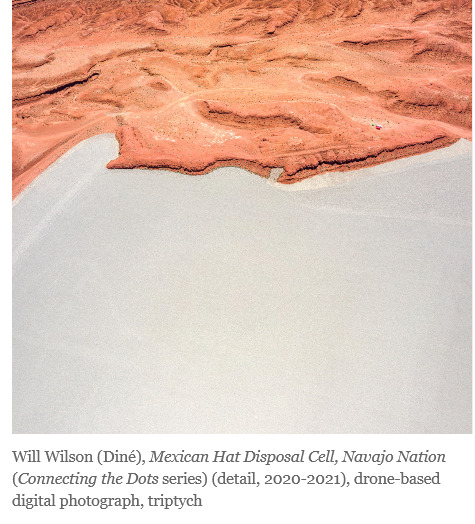
“What we’re doing with this exhibition is giving international Indigenous artists a voice to comment on the impact of nuclear exposure, like here in New Mexico, from the first atomic bomb development and tests but also from uranium mines,” Well-Off-Man says. “Similarly, in Australia, there were atomic bomb tests throughout the 1950s and ‘60s. Like here, with our uranium mines, these tests were conducted on Aboriginal land, without consulting with tribal governments and tribal elders. The government tried to move entire communities, but they didn’t really explain what would happen, and some of the Aboriginal tribal members stayed on the land. They never got the message, and they got severely sick or died of cancer.” [...]
A visual motif in the form of biohazard and radiation symbols runs through the exhibition. Samoan artist Dan Taulapapa McMullin’s Radiation Mats (2021) are intended as markers, alerting the viewer that the separate spaces are part of the same show. They also reflect the exhibition’s theme. The symbols are superimposed over photographic imagery of landscapes and people of the Bikini Atoll, whose inhabitants were forcibly removed in 1946 in advance of a series of nuclear tests conducted by the United States the following decade. When the inhabitants were allowed to return, more than two decades later, they were poisoned by high concentrations of the radioactive isotope Caesium-137 and high levels of Strontium-90 in the well water, prompting mass evacuations in 1980 [...]

Other works by McMullin include Clouds (2021), a video installation that places the history of nuclear testing in American Micronesia and French Polynesia into a contemporary context, and Te Mau Ata: Clouds (2021), a photo-collage depicting Bikini’s displaced people and French Polynesia’s anti-nuclear and independence activists amid the eponymous mushroom clouds created by nuclear blasts.
It’s significant that Exposure, which travels next year, launches in New Mexico, where the first atomic bomb test was conducted. That event was a precursor to the first deliberate use of a nuclear weapon (on the Japanese cities of Hiroshima and Nagasaki on Aug. 6 and 9, 1945) mere weeks after the historic test at Trinity Site, New Mexico, on July 16. [...]
Well-Off-Man organized the exhibition in collaboration with guest curators from around the world, including iBiennale Director Kóan Jeff Baysa, Hokkaido Museum of Modern Art Chief Curator and Vice Director Satomi Igarashi, and independent curator Tania Willard (Secwepemc Nation).
-------
Headline, images, captions, and all text published by: Michael Abatemarco. “Invisible invader: Indigenous artists respond to the nuclear legacy.” Santa Fe New Mexican. 20 August 2021.
3K notes
·
View notes
Text
HELLO BEAUTIFUL PEOPLE. Today's post is about:
🇼🇸🌴Samoa🌴🇼🇸
If you didn't know, Samoa is a State made of a group of 💫paradisiac💫 islands in Polynesia, near New Zealand and Australia, riiiiight here:

The best place for a vacation, right?
Samoan people are bilingual (speaking English and Samoan), so if you happen to be in Apia (Samoa's Capital) and want to make friends, you can say:
Hello = Malō (informal) / Tālofa
How are you? = Ua mai oe?
Thank you = Fa'afetai
Please = Fa'amolemole
Yes = Ioe
No = Leai
Sorry = Fa'amalie atu
I don't know = Ou te leiloa
Have a nice day! = Ia manuia le aso!
I understand = Ua ou mālamalama
I don't understand = 'Ou te lē mālamalama
Help! = Fia ola!
Excuse me = Tulou lava
I miss you = Ou te misia ia te oe
I love you = Ou te alofa ia te oe
One language is never enough = O le gagana e tasi e le lava
Source:
👉 You wanna learn the Samoan writing System? No problem.
The Samoan Language uses the latin alphabet plus 'Okina, the symbol (') used in writing to represent a glottal stop, similar to the sound between the syllables of "oh-oh", and kahakō, which when written over a vowel indicates that the vowel is long.
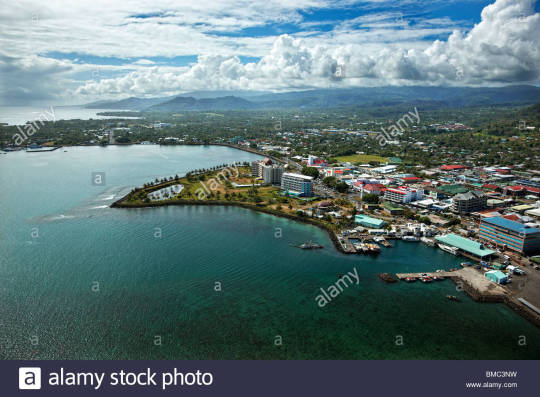
Samoa's Capital, Apia
🌴But let's look more into Samoan Culture
Samoan culture is based on Faʻa Sāmoa, the 'Samoan Way'.
It includes the behavior and the responsibilities that spell out all Samoans' relationships to one another and to persons holding positions of authority.
Faʻa Sāmoa includes the way one stands, walks and speaks, for example by saying "tulou" when one walks in front of someone who is seated. Likewise, it is extremely disrespectful to eat or drink when walking through a village.
"Family" in samoan is ʻAiga.
'Aiga consists of a wider family group of blood and marriage or even adopted connections who all acknowledge the matai (head of the family) who can be either male or female.
All members of the 'Aiga don't have to live under the same roof or even in the same village but it will assemble when the occasion requires it, generally at the residence of the matai, to discuss family affairs, deaths or weddings.

Samoan matai protestors outside Aotearoa New Zealand's Parliament. On 28 March 2003, this group of 3000 Samoans, among them hundreds of transnational matai, protested against the Citizenship [Western Samoa] Act 1982 outside Parliament. Image: Mark Mitchell
🔥Dancing is a huge part of Samoan culture.
There's many traditional samoan dances:
The Fa'ataupati, or "Samoan Slap Dance". Only performed by males, it's the only dance withouth music but with the clapping of the hands and stomping of the feet.
The Maulu'ulu. Literally it means "light rain" - due to the refreshing movements and style, as a "light rain" would cool the stifling tropical heat of a summer day.
The Sasa can be performed by both males and females.
The Siva Afi, a ceremonial dance using the fire knife.
The Manu Siva Tau is a Samoan War Dance, performed by the Samoan sporting teams before each match.
The Taualuga, considered the apex of Samoan performance art forms.
🌈Lgbtq+ in Samoa
Even though same sex relationships are illegal, Samoa has a large transgender or "third gender" community called fa'afafine.
Faʻafafine are people who identify themselves as having a third gender or non-binary role in Samoa.
They are assigned male at birth, and embody both masculine and feminine gender traits. Their behaviour typically ranges from extravagantly feminine to conventionally masculine.

A curious fact about Samoa is that male relationships are forbidden, while female ones are not.

A book about this general topic was written by the Samoan artists Dan Taulapapa McMullin and Yuki Kihara.


🌴☀️🌴☀️🌴☀️🌴☀️🌴☀️🌴☀️🌴☀️🌴☀️
If you read until now and learned something new, I'm proud of you!
And so are some Samoan characters you didn't know were Samoan, like:
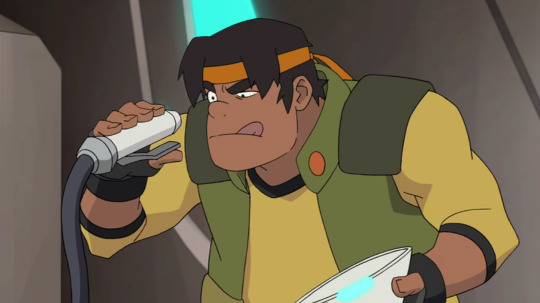
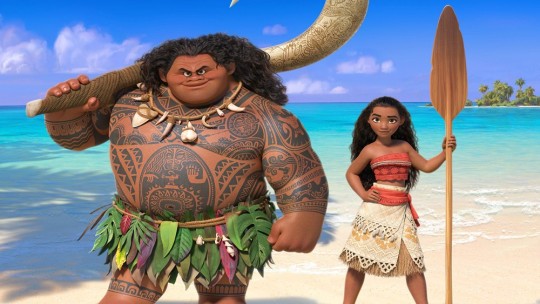
And last but not least,
If you want to learn Samoan or just want to look more into its culture, check this:

Nafanuatele Lafitaga Mafaufau, the creator and writer of O Le Aiga Samoa comic, is the passionate founder and teacher of the Nafanua Communication and Culture Samoan language classes.
This comic helps to make the Samoan language accessible to people of all ages and backgrounds, and its goal is to make especially young people engage in Samoa's beautiful culture.
https://www.boosted.org.nz/projects/o-le-aiga-samoa
#It took me the whole day to make this post and I'm kinda proud of it#All sources are linked#I hope you enjoy it and please if I made some wrong statements correct me in the comments#Samoa#Samoan#Samoan language#Hunk garrett#Moana#Oceania#Languages#Culture#Polyglot#Vld#Voltron#Lgbtq#World#Language#Country
821 notes
·
View notes
Link
1 note
·
View note
Text
books i want to read/my tbr list 2021
(updated as i read)
last update: 1/15/2021
T/ marks books that are politically informative, economic theory, race theory, class theory, feminist theory, etc. --> also, if you read theory or want to, i would 100% recommend you just search for the .pdf and not buy it (don’t waste your money, seriously) like i would persuade you to do so, there are so many free resources out there as well (podcasts, youtube vids, etc.), i personally don’t read a lot of theory because i understand a lot of the concepts from... well my life and own experiences but i have been meaning to read more this year so... yeah
not in order of how i want to read but as they are finished, they will be moved to the top
We Were Liars by E. Lockhart : finished on 1/10
The Song of Achilles by Madeline Miller : finished on 1/14
The Unhoneymooners by Christina Lauren : tbr
The Great Gatsby by F. Scott Fitzgerald : tbr
The Bridgerton Series by Julia Quinn : tbr
T/ Wage Labour and Capital by Karl Marx : tbr
T/ The Meaning of Freedom and Other Difficult Dialogues by Angela Y. Davis : in progress (start 1/13)
The Stranger by Albert Camus : tbr
T/ The Principles of Communism by Frederick Engels : tbr
T/ Queer Indigenous Studies (A collection of queer indigenous studies: Critical Interventions in Theory, Politics, and Literature) authors include Chris Finley, Andrea Smith, Michelle Erai, Dan Taulapapa McMullin, etc. : tbr
T/ George Padmore: A Critique. Pan Africanism or Marxism? by Paul Trewhela : tbr
T/ The State and Revolution by V. I. Lenin : tbr
T/ Visual Pleasure and Narrative Cinema by Laura Mulvey : tbr
T/ Blackshirts & Reds: Rational Fascism & the Overthrow of Communism by Michael Parenti : tbr
The Autobiography of Malcolm X by (told by) Alex Haley: tbr
T/ Profit and Pleasure: Sexual Identities in Late Capitalism by Rosemary Hennessy : tbr
T/ Freedom is a Constant Struggle: Ferguson, Palestine, and the Foundations of a Movement by Angela Y. Davis : tbr
T/ The Wretched of the Earth by Jean-Paul Sartre : tbr, excited for this one since i love learning about colonialism
Fahrenheit 451 by Ray Bradbury : tbr
T/ Socialism: Utopian and Scientific by Frederick Engels : tbr
T/ Guerilla Warfare: A Method by Ernesto Che Guevera : tbr
The Catcher in the Rye by J.D. Salinger : tbr
T/ Are Prisons Obsolete? by Angela Y. Davis : tbr, excited!!
A Tale of Two Cities by Charles Dickens : tbr
The Girl with the Dragon Tattoo by Stieg Larsson : tbr
The Secret History by Donna Tartt : tbr
The Picture of Dorian Gray by Oscar Wilde : in progress (start 1/15)
People Like Us by Dana Lee : tbr
Catherine House by Elisabeth Thomas : tbr
The Iliad and The Odyssey by Homer : i’ve read them before but i have been meaning to do a nice reread
The Hating Game by Sally Thorne : tbr
The Vanishing Half by Britt Bennett : tbr
<3
#toberead#2021 tbr#tbr#reading#currently reading#books#book reccs#reading recommendations#book recommendations#theory#theory recommendations#my tbr#this is so long#lol#books recs#my reading list
5 notes
·
View notes
Photo

Abstraction of the poem, “Turtle Island Poem Number Three” By Dan Taulapapa McMullin In, “coconut milk” Gouache & Watercolor On Yupo Heavy 7”x5” 8 June 2022 #abstract #contemporary #artofinstagram #collectart #curate #color #poem #music #joejackson #lsaccoccio7 #california #june #2022 https://www.instagram.com/p/CekM2ealHkn/?igshid=NGJjMDIxMWI=
#abstract#contemporary#artofinstagram#collectart#curate#color#poem#music#joejackson#lsaccoccio7#california#june#2022
0 notes
Photo









Placeholder (there/here storage) (2020) with Dan Taulapapa McMullin’s Their story at studio-gallery of artist Mitch Cairns - ANKLES, Sydney
image credit: Jessica Maurer
0 notes
Photo




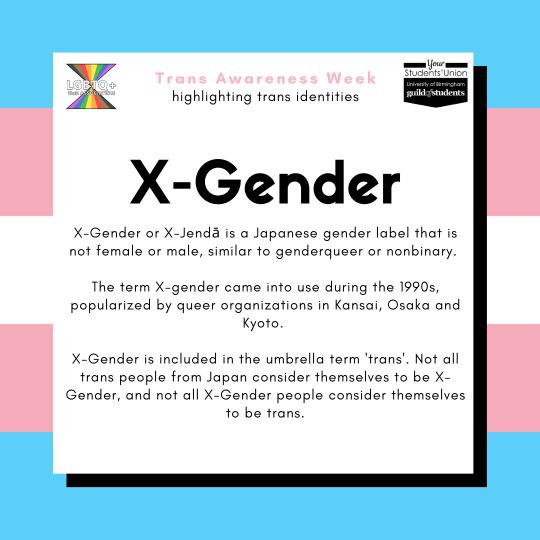

On day 6 of Trans Awareness Week we are looking at the gender labels Fa'afafine and X-Gender, from Samoa and Japan respectively. We are also trying to move from sharing information about genders and communities which our committee members are not a part of, to sharing resources made by those individuals and communities. In doing so, we hope to avoid perpetrating colonial perspectives of non-Western, culturally-specific genders, and to amplify marginalised voices rather than talking over them. These resources are linked below.
Two-Spirit resources:
Tribal Two-Spirited Identity – a talk by Native Out, a nonprofit organisation: https://ihs.cosocloud.com/p8eethowecj/?proto=true
Native Out’s Facebook page: https://www.facebook.com/nativeout
Two Spirit: The Story of a Movement Unfolds – an article from Native People’s Magazine: https://www.kosmosjournal.org/.../two-spirit-the-story.../
Two Spirit: The Trials and Tribulations of Gender Identity in the 21st Century – an article from Indian Country Today: https://indiancountrytoday.com/.../two-spirit-the-trials....
Kinnar resources:
Kinnar Ka Ki – The Story Of Four Transwomen, Their Journeys And Vision – an photo essay, “not about, but by” four Kinnars: https://feminisminindia.com/.../kinnar-ka-ki-story-of.../
Transgender India has several threads on Kinnar identity: https://transgenderindia.com/talk/
India’s Third Gender Rises Again – an article by an Indian anthropologist on Kinnar identity and culture. This article uses language that is considered outdated and/or harmful by some Kinnars: https://www.sapiens.org/biology/hijra-india-third-gender/.
M��hū resources:
A glossary and selection of resources on Hawai’ian culture and gender: https://aplaceinthemiddle.org/resources
Aha Kāne 2012- Māhū – A video of a māhū person talking about their identity and experiences: https://vimeo.com/45104464
LGBTQI Hawai‘i – a needs assessment of LGBTQ+ people in Hawai’I, written by non-Native Hawai’ian academics living in Hawai’i: https://scholarspace.manoa.hawaii.edu/handle/10125/34267.
Fa’afafine resources:
Samoa Faafafine Association Incorporated Facebook page: https://www.facebook.com/sfainc/
The Bent Spoon - a web series using food as a way to bring LGBTI communities together, presented by a Polynesian trans woman and featuring several fa’afafine guests: https://www.youtube.com/watch?v=19B4wqvj5po...
Writings by fa’afafine Dan Taulapapa McMullin on queer Samoan identities and culture: https://www.taulapapa.com/writings.html.
X-Gender resources:
An Introduction to X-Jendā: Examining a New Gender Identity in Japan – an paper by a Japanese academic looking at X-Gender in detail: http://intersections.anu.edu.au/issue31/dale.htm
Pushing for 'X-gender' recognition – a news article by two Japanese writers from NHK World-Japan: https://www3.nhk.or.jp/nhkworld/en/news/backstories/576/
A selection of resources in Japanese and English: https://genderqueerid.com/.../selected-links-on-non...
Nonbinary in Japan – a blog by a non-Japanese resident of Japan: https://www.abnrmljapan.com/home/nonbinary-in-japan.
[Image descriptions:
Image 1:
A white square with a black shadow, against a background in the colours of the trans flag: horizonal stripes in light blue, light pink, white, light pink, light blue.
Pink and black text in the centre of the white square reads:
"Trans Awareness Week
highlighting trans identities
In light of a recent mistake on our part and on the advice of some of our members, we have decided that when sharing information about gender identities specific to any oppressed communities that our committee members are not a part of, we will focus on promoting resources that have been created by individuals and/or groups who identify with those gender identities. We should aim to amplify their voices rather than speak over them.
In the description for this post are educational resources specific to Two-Spirit, Kinnar, Māhū, Fa'afafine, and X-Gender identities, largely created by members of those communities. We encourage our members to learn more about these identities from those who have direct experience with them."
In the top left corner of the square is the LGBTQ+ Association logo (two prisms in the colours of the inclusive pride flag, with black text over them reading "LGBTQ+ UoB ASSOCIATION"). In the top right corner is the Guild of Students logo (black and white text reading "Your Students' Union University of Birmingham guild of students").
End image 1.
Image 2:
A white square with a black shadow, against a background in the colours of the trans flag.
Pink and black text in the centre of the white square reads:
"Trans Awareness Week
highlighting trans identities
Fa'afafine and X-Gender"
In the top left corner of the square is the LGBTQ+ Association logo. In the top right corner is the Guild of Students logo.
End image 2.
Image 3:
A white square with a black shadow, against a background in the colours of the trans flag.
Pink and black text in the centre of the white square reads:
"Trans Awareness Week
highlighting trans identities
Fa'afafine
Faʻafafine is a third-gender or nonbinary role in Samoa, American Samoa and the Samoan diaspora. A recognized gender identity/gender role in traditional Samoan society, faʻafafine are assigned male at birth and embody both masculine and feminine gender traits in a way unique to Polynesia.
The word faʻafafine includes the prefix faʻa–, meaning "in the manner of", and the word fafine, meaning "woman". The transmasculine equivalent term is faʻatane, faʻatama, or fafatama.
Fa'afafine is included in the umbrella term 'trans'. Not all transfeminine people from Samoa consider themselves to be fa'afafine, and not all fa'afafine consider themselves to be trans."
In the top left corner of the square is the LGBTQ+ Association logo. In the top right corner is the Guild of Students logo.
End image 3.
Image 4:
A white square with a black shadow, against a background in the colours of the trans flag.
Pink and black text in the centre of the white square reads:
"Trans Awareness Week
highlighting trans identities
Jaiyah Saelua (she/her) is a fa'afafine American Samoan international football player. She is a member of the American Samoa national football team, which is nominally a men's team. She is the first transgender international football player.
Jaiyah is a FIFA ambassador for equality and LGBT athletes. She is featured in the 2014 documentary Next Goal Wins. A feature film version of the documentary will feature Kaimana, an actor who is also a fa'afafine, as Saelua, and will be directed by Taika Waititi."
There are two photos of Jaiyah, an American Samoan fa'afafine with long black hair. In one she is wearing a grey top and smiling. In the other she is wearing a football kit and playing with a football.
In the top left corner of the square is the LGBTQ+ Association logo. In the top right corner is the Guild of Students logo.
End image 4.
Image 5:
A white square with a black shadow, against a background in the colours of the trans flag.
Pink and black text in the centre of the white square reads:
"Trans Awareness Week
highlighting trans identities
X-Gender
X-Gender or X-Jendā is a Japanese gender label that is not female or male, similar to genderqueer or nonbinary.
The term X-gender came into use during the 1990s, popularized by queer organizations in Kansai, Osaka and Kyoto.
X-Gender is included in the umbrella term 'trans'. Not all trans people from Japan consider themselves to be X-Gender, and not all X-Gender people consider themselves to be trans."
In the top left corner of the square is the LGBTQ+ Association logo. In the top right corner is the Guild of Students logo.
End image 5.
Image 6:
A white square with a black shadow, against a background in the colours of the trans flag.
Pink and black text in the centre of the white square reads:
"Trans Awareness Week
highlighting trans identities
Yuhki Kamatani (they/them) is a Japanese manga artist and illustrator, best known for their series Nabari no Ou. They are X-gender and asexual, and they note their gender as toX, without revealing their assigned gender at birth.
Yuhki's manga frequently features characters in transitional life stages and issues regarding identity and marginalization. In Shimanami Tasogare (published in North America as Our Dreams at Dusk: Shimanami Tasogare), they depict queer characters coming to terms with their identity."
There is one photo of Yuhki, a Japanese X-Gender person with short black hair. They are wearing a yellow t-shirt and are holding a microphone. There is also a self-portrait by Yuhki of themself as a grey cat in a pile of orange leaves.
In the top left corner of the square is the LGBTQ+ Association logo. In the top right corner is the Guild of Students logo.
End image 6]
0 notes